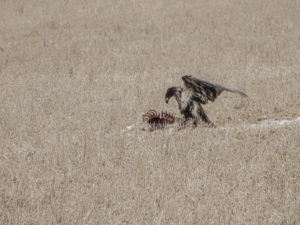
There is nothing left of the carcass. The bones have sunk down into the muddy weeds or have been scattered about the field and the tawny hair of the deer blends so perfectly with the winter dried grasses that it is invisible. It took but three days for the road killed doe to be reduced to a memory. But for those three days it was a scene of endless drama. I glimpsed the lump of her body first in the early morning. By the time I drove past a few hours later the magpies had found her and it looked as if the field were aflutter with giant iridescent blue and white butterflies. Next came the ravens and I watched as a hierarchy of corvids established themselves—a few feeding while the others stood apart awaiting their turn. Meanwhile the magpies snuck in, snatching pieces of red meat while avoiding the snapping black beaks of the ravens who chased them off. Cars rushed past on their way to town oblivious of the drama playing out in the field.
By evening a bald eagle had arrived, his white head I first mistook as a patch of leftover snow. The eagle asserted his primacy on the carcass and now the ravens were the ones who had to try to sneak a morsel. The magpies flew overhead circling, but giving up on getting any closer. The eagle, though white headed, still sported a few streaks of brown on the back of his neck, so he was young.
Then the gang of immature eagles arrived, still in their brown plumage, four in all and they surrounded the carcass, pushing the solitary older eagle off, then taking turns feeding on the dwindling meat. For the rest of the second day, and part of the third, the young eagles dominated, the white headed elder picking at a bone some distance away and the ravens and magpies trying an occasional end run around a feeding raptor. By that evening, the ravens and magpies were finishing off whatever remained.
Watching all this I was acutely aware of the program I had just seen the week before at the Montana Natural History Center. The eagle researcher from the MPG ranch, which lies just south of here, described their studies of migration patterns and their capture and banding of the eagles who frequent the ranch. I peered through my binoculars trying to see if any of these eagle were tagged, but none appeared to be. I was also acutely aware of what the researcher had said about the alarming amount of lead they found in so many of the eagle’s blood.
With climate change and facing the next great extinction, it is easy to feel helpless in the face of these global problems. But here was a one small contribution toward preservation that anyone who hunts can take. While this particular deer had been hit by a car and not shot, the quick and efficient way the birds had eliminated the dead doe was a clear illustration of how these scavengers, feeding on carcasses and gut piles left by hunters using lead ammunition can be poisoned. A simple switch to copper bullets could make a huge difference in the lead contamination in the environment and seems a no-brainer for anyone who cares about the future.

enjoyed reading this – and lucky smile I got to hear it read aloud first…like where you took it at the end re: bullets